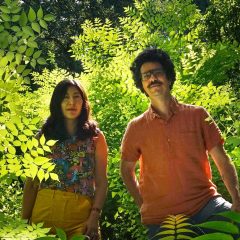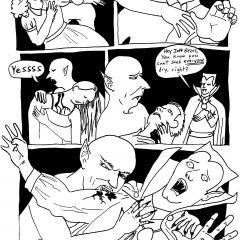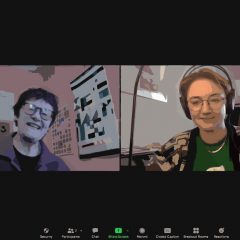[In the fourth and final installment of her extended series on artist Paul Chan, Mari Shaw examines Chan’s publications, and speculates on the direction the artist’s future work might take. The series appeared here on Sundays in October. — the Artblog editors]
Three publications accompany the exhibition; they are not only an integral part of it, but are also thought-provoking treasures in themselves, stimulating and enabling one to see more in the exhibition long after it ends. Chan does not include an index in any of them–a canny move that causes one to look through them over and over again, seeing and learning something more each time.
The search for meaning
A 2,000-plus-page New, New Testament reproduces Chan’s “Volumes” (2012), shown in its entirety for the first time in the exhibition. “Volumes” is a block of 1,005 books with all the pages torn out of them, and their covers painted with different images and colors.

In The New, New Testament, the image of each book in “Volumes” appears with Chan’s commentary about it on its facing page, but the commentaries are composed of symbols; Chan-created fonts; and wisdoms that are often difficult to comprehend, let alone relate to the image on the opposite page.
Chan’s Selected Writings is a compilation of Chan’s previously published writings and the texts of talks he has given. Each is short, but packed, giving different and new insights with each reading.
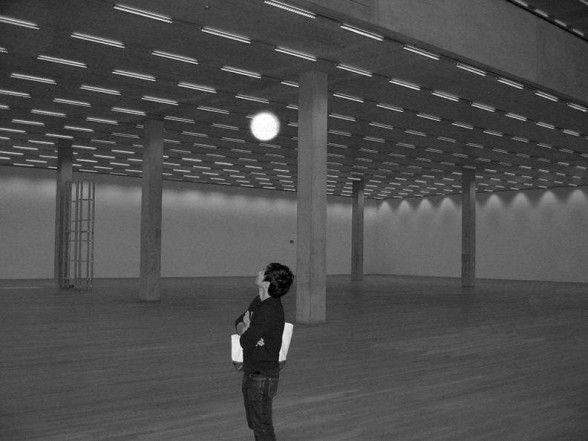
The third publication, the Exhibition Catalogue, opens with a concrete poem of symbols and type fonts amidst a few English and Twitter words: “Stranger, u, r…. a, proper,” and “proteus” (Homer’s mythical god of the sea, who can foretell the future, but changes his shape to avoid having to do so). The first image in the catalogue is a small black-and-white image of Chan looking up to the ceiling/sky in the empty gallery space at a celestial, glowing sphere. Lines of uniform neon lights in the ceiling stand in for stars and constellations. It is a visual image of Chan’s conflicting drive to understand the universe, yet at the same time, enjoy the state of not understanding. Chan asks in his Selected Writings: “Who has not looked up at the sky, in desperation, for a sign, for something? And why?” and then questions, “Why? Why?”
Installation shots and Greek influences
Early in the catalogue come unnumbered, stunning installation shots. The installations, not individual works, are the stars of the exhibition. Chan has appropriated from himself to do a survey of his last 14 years with new work made from old work or work never previously exhibited. Many original Chan “works” are split up and rearranged in such a way that the original work no longer exists (but will again when returned to its lenders after the exhibit), and the new “works” are the installations resulting from the rearrangements. Many of the works for this exhibition were made in secret for the last two to three years (a la Marcel Duchamp creating “Étant donnés” in secret), and have never been previously shown. Others are works that were shown singly, but are now exhibited in large groups for the first time, which makes them become new.
Chan has managed to show the old as the new so that he can display the past, while constantly being in the present, traveling to the future. He wants to ensure that his survey show not be mistaken for a retrospective, which, at age 40, he certainly does not want it to be. To Chan, it is important to remain on the journey. Arrival means an end to creating, investigating, as he revealed in one of his Sade Font poems, “Oh Untitled”. Immediately after “Oh Untitled,” in bold letters, he writes: “What is missing? Silence, exile, cunning. Odysseus had it but then he came home”.
Following the installation shots come sections of more than 250 unnumbered pages of “Selected Source Files” keyed to rooms in the exhibition. The Source File pages juxtapose handwritten diagrams, drawings, charts, lists, quotations, stream-of-consciousness ponderings, photographs, pictures, and partial pages usually from unidentified sources: a voyage through Chan’s mind. Each time I look through the unnumbered source file pages, to find a remembered thought or image, I get distracted discovering things I previously overlooked, seeing them differently or finding other relationships among them. It is like looking through the two eyeholes in the door of Marcel Duchamp’s “Étant donnés”: voyeuristic and puzzling and drawing you back for repeat visits.
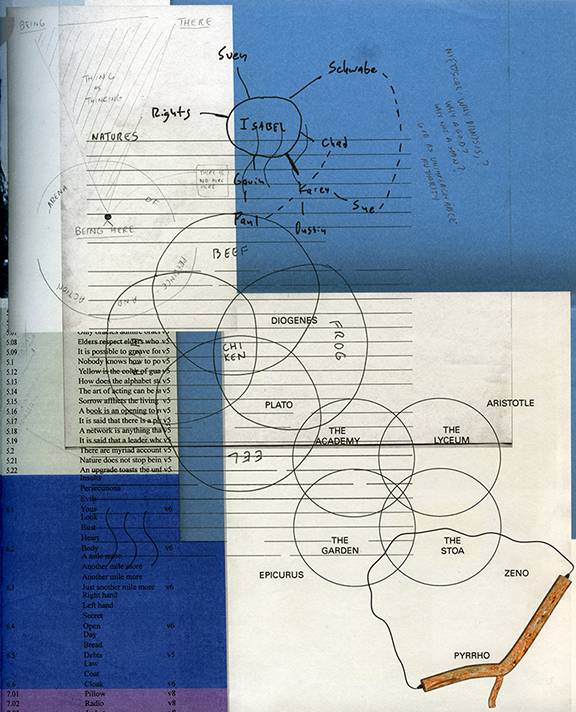
For example, though never mentioned, Stoicism, a philosophical movement in the Hellenistic period, anchors the conceptual design plan for part of the exhibition. On one page of the source files, Chan names Pyrrho (ancient Greek artist-turned-Stoic-philosopher-turned-hedonist) in the lowest of several overlapping circles. Unlike the other circles in the group, this one is irregular and bound by a branch: it is an image of Chan’s cord-and-wood floor sculpture, “Nature” (2013), which appears in the exhibition. The name “Zeno,” the father of Stoicism, famous for his paradoxes, also appears in the irregular circle image of “Nature,” as does “The Stoa”. The name Stoicism is derived from the columned porch (stoa poikilê) in the Agora at Athens. Zeno and other Stoics congregated and lectured at the Stoa Poikilê, famed for its murals portraying mythological heroes and heroic battles. Zeno also taught at the Lyceum and the Academy, which are each named in an interlocking circle in this schema, as is “Garden”. The Epicurean Garden lies near the Stoa. The name of ancient Greek philosopher Epicurus, who founded Epicureanism, lies right beside the Garden circle in Chan’s schema. “Garden” (2012) is a cord-and-outlet sculpture in the exhibition.
The Stoics believed that emotions like fear, envy, and passionate love arise from false judgments, and one should strive to overcome them and obtain intellectual, dispassionate calm. Pyrrho came to believe that literal truth is difficult to distinguish, if not impossible to know. Zeno taught limiting what we call “true” to that which can be seen or scientifically provable. Stoic ethics fall within the philosophical framework handed down by paradox-exploring Aristotle, whose name appears outside one of the circles. This truth-telling/not truth-telling and paradox permeate Homer’s mythos.
Plato is named in a hand-drawn circle that intersects with the corner of one of the regular overlapping circles, and also centers another connecting schema of hand-drawn, imperfectly shaped rounds. Plato (whose punned name “Play-Doh” is the title of a sculpture in the exhibition) likened philosophy to a living animal, and the imperfect round schema he centers is of animals edible in some cultures but not others—Eel, Frog, “Chiken,” and beef. Animals, their symbolism, powers, and whether they should be revered or eaten are omnipresent in Greek mythology and Chan’s work, including many of his works in the exhibition. Greek philosopher Diogenes (whose punned name “Die All Jennies” is the title of another of the sculptures in the exhibition) appears in this schema as well. A critic of cultural conventions, Diogenes helped found the School of Cynicism eventually passed on to Zeno, who integrated it into what would become Stoicism.
These circle diagrams constitute only part of one of the 250 pages of source files, and my comments about them are only a sliver of their meanings. I suspect the layout also relates to the layout of Basel, where Chan taught at two different universities during the months he spent in the old Swiss city preparing for the exhibition. Basel’s history as a place of learning made a deep impression on Chan. He was particularly impressed that one of his heroes, Friedrich Nietzsche, chaired a department in Basel for 10 years, and Nietzsche is mentioned and seemingly quoted in the upper part of this same page.
Only 34 pages of the 338-page exhibition catalogue are devoted to comments on certain themes in the exhibition, and thumbnail sketches of Chan’s work being exhibited in their original form. (There is also a fine introductory essay by Daniel Birnbaum.)
A new chapter for Chan
In the exhibition and publications, the 40-year-old Chan both introduces a comprehensive survey and documentation of his work over the last 14 years and ends this chapter of his practice with new work. To end this chapter of his practice, Chan removed from his website the series of True Type Fonts he created and made available for download over the last 14 years. They shall be downloadable no more. Throughout the exhibition hang cords that sometimes look like wire drawings, and sometimes connecting wires, and sometimes wires that lead to dead ends. At the end of the exhibitions are projectors that do not project. Chan writes:
A work works by not working at all. By not obeying the law of any system or authority external to the process of its own making, a work emphatically expresses its own right to exist for itself and in itself, and questions–by merely existing–the rule of law that works to bind all to a semblance of the common good. Art is a lawless proposition.
Chan has cleared the clutter of his 14-year practice so he can reevaluate and move on:
Perhaps the task of art today is to remake this burden (the terror of action and inaction in art-making) by suspending the seemingly inexorable order of things…and allowing a kind of clearing to take place so that we can see and feel what is in fact worthless–and what is in truth worth renewing.
(Chan said at the opening of his exhibition that right now, only light, time, and relationships interest him.)
Light, a concept of symbolic and meaningful importance in mythos, has long been an interest of Chan’s, particularly commented upon in discussions of his The 7 Lights series, much of which is in the exhibition. Chan elucidates in his writing, “On Light at Midnight and Noon,” the blindingness of contemporary moving images and the blindingness of depictions of divine illumination that dissolves details in his haze (bringing us back to the ancients). Under “Tomorrow,” in that essay, he writes of the virtues of dark where only slivers of reflected light emerge (like in his projectors, which do not project but show a blur of light if you look straight into them), “a kind of light that transmits–in its lack–the very shape of things.” (Transmission and relationships that define things lead straight back to Hesiod and Chan’s Argument series of wires that transmit, communicate, and do not).
Kairos, the moment in time the Greeks believe presents the opportunity to seize new possibilities, will present Chan with endless possibilities. His ability to endure, even flourish, in not knowing or understanding and integrating the reality of death will impel him to make use of every minute of precious time during the slow, sequential marking of time, which the Greeks called chronos, until kairos arrives.
When the time is right, will the light enable Chan to begin a new voyage of inner contradiction and tough honesty in this New, New world and enlighten us to begin our own? Will he write a New, New Odyssey? Being fully conscious of his own mortality, will he go further underground to make the best use of the precious time he has left, as his influencer Marcel Duchamp advised successful artists do? Or will he gear up his political activities to promote lawlessness and higher truths in a world that is more and more in need of such actions? Or none of the above?
Only time will tell what comes next. It is urgent that time must be used to its utmost, but kairos cannot be rushed.


